The art of ancient Greece and Rome has had a profound and lasting influence on modern culture in various ways. Their artistic achievements, styles, and themes continue to resonate and shape the way we perceive and create art today. Here are some key ways in which Greek and Roman art have influenced modern culture:
Aesthetic Ideals and Beauty:
Greek art emphasized ideals of beauty, proportion, and symmetry. The concept of the “ideal human form” that emerged in Greek sculptures, such as the famous “Venus de Milo” and “Discobolus,” has left a lasting impact on Western notions of physical beauty and aesthetics.
Architectural Forms:
Both Greek and Roman architecture have influenced the design of modern buildings. The use of columns, pediments, and arches in classical architecture can be seen in government buildings, museums, and monuments around the world.
Democratic Ideals and Governance:
The concept of democracy and civic participation in ancient Greece influenced modern political thought. The idea of a citizenry participating in decision-making and the public sphere has influenced the foundations of modern democracies.
Mythology and Iconography:
Greek and Roman myths and gods have served as inspiration for literature, art, and popular culture throughout history. Their stories and symbols continue to be referenced in literature, movies, and other forms of media.
Literature and Drama:
Greek theater, with its tragedies and comedies, laid the groundwork for modern theater and drama. The themes explored in ancient plays, such as the complexities of human nature, continue to be relevant in contemporary storytelling.
Language and Vocabulary:
Many words and concepts in modern languages have origins in ancient Greek and Latin. For example, scientific terminology, legal terms, and medical jargon often have roots in these languages.
Sculpture and Portraiture:
The Roman practice of creating realistic portraits of individuals has influenced the tradition of portraiture in art. Modern portraiture often draws inspiration from the attention to detail and expression seen in ancient Roman sculptures.
Mosaics and Murals:
The intricate mosaic patterns and wall paintings found in ancient Roman villas and buildings have inspired contemporary interior design and artistic techniques.

The enduring legacy of Greek and Roman art lies in their ability to capture universal human experiences, explore fundamental concepts, and provide inspiration for creativity across various fields. Through the continued study, appreciation, and reinterpretation of these artistic traditions, their influence remains a vibrant part of modern culture.










